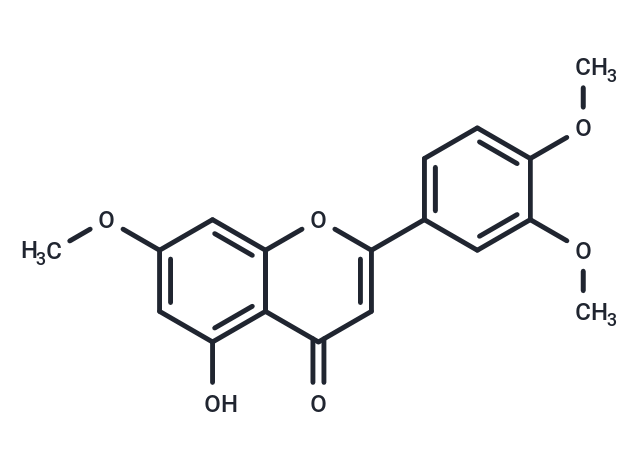Shopping Cart
- Remove All
 Your shopping cart is currently empty
Your shopping cart is currently empty

7,3',4'-Tri-O-methylluteolin (5-Hydroxy-3',4',7-trimethoxyflavone) exhibits anti-inflammatory, antibacterial, and antifungal activities, along with moderate antitrypanosomal activity, having an MIC value of 19.0 µg/mL.

| Pack Size | Price | Availability | Quantity |
|---|---|---|---|
| 1 mg | $89 | In Stock | |
| 5 mg | $178 | In Stock | |
| 10 mg | $278 | In Stock | |
| 25 mg | $475 | In Stock | |
| 50 mg | $682 | In Stock | |
| 100 mg | $948 | In Stock | |
| 1 mL x 10 mM (in DMSO) | $197 | In Stock |
| Description | 7,3',4'-Tri-O-methylluteolin (5-Hydroxy-3',4',7-trimethoxyflavone) exhibits anti-inflammatory, antibacterial, and antifungal activities, along with moderate antitrypanosomal activity, having an MIC value of 19.0 µg/mL. |
| In vitro | 7,3',4'-Tri-O-methylluteolin significantly inhibited nitric oxide production and demonstrated slight reduction in prostaglandin-E2 level at tested concentrations. The production of pro-inflammatory cytokines, such as TNF-α±, IL-6, and IL-1β, were obviously reduced by 7,3',4'-Tri-O-methylluteolinin a concentration-dependent manner. Moreover, 7,3',4'-Tri-O-methylluteolinsignificantly induced reduction in the mRNA expressions of inducible nitric oxide synthase and cyclooxygenase-2, representing that inhibition occurs at the transcriptional level. In addition, we performed molecular docking and molecular dynamic simulations to study the interaction of 7,3',4'-Tri-O-methylluteolinwith inflammatory mediators such as inducible nitric oxide synthase and cyclooxygenase-2. Docking study showed its hydrogen bond interactions with key residues in the active site of inducible nitric oxide synthase and cyclooxygenase-2, enlightening its possible binding mode at the molecular level. The results of molecular dynamic simulations showed the stability of complexes and their interactions[1] |
| Alias | 5-Hydroxy-3',4',7-trimethoxyflavone |
| Molecular Weight | 328.32 |
| Formula | C18H16O6 |
| Cas No. | 29080-58-8 |
| Smiles | COc1cc(O)c2c(c1)oc(cc2=O)-c1ccc(OC)c(OC)c1 |
| Relative Density. | 1.314 g/cm3 (Predicted) |
| Storage | keep away from direct sunlight | Powder: -20°C for 3 years | In solvent: -80°C for 1 year | Shipping with blue ice. | |||||||||||||||||||||||||
| Solubility Information | DMSO: 9 mg/mL (27.41 mM), Sonication is recommended. | |||||||||||||||||||||||||
Solution Preparation Table | ||||||||||||||||||||||||||
DMSO
| ||||||||||||||||||||||||||

Copyright © 2015-2025 TargetMol Chemicals Inc. All Rights Reserved.